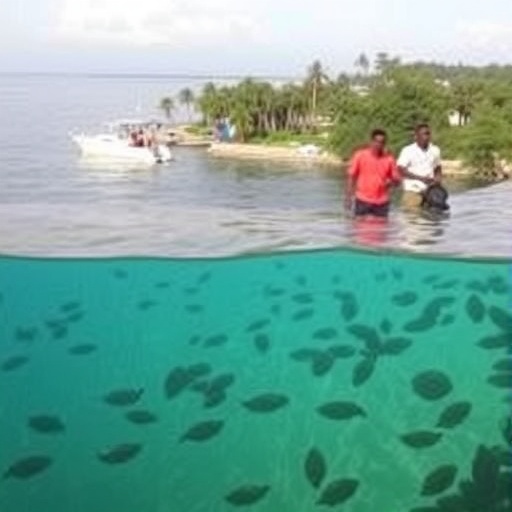In a recent and groundbreaking study, researchers Adeleye, Oyatola, and Adegbite investigated the distribution, source identification, and ecological risk assessment of organochlorine pesticides (OCPs) and polycyclic aromatic hydrocarbons (PAHs) within the Apapa-Badagry creeks, located along the western shoreline of Lagos Lagoon in Nigeria. This research is of paramount importance as it sheds light on the ecological ramifications of these harmful pollutants in one of Nigeria’s most critical aquatic ecosystems, which are often subjected to various human activities.
The Apapa-Badagry creeks are vital for both local biodiversity and the community that relies on them for sustenance and commerce. However, the increasing urbanization and industrialization in Lagos raise significant concerns about the ecological health of these water bodies. The significance of this study lies in its meticulous approach to understanding how human activities contribute to the distribution of hazardous contaminants like OCPs and PAHs, which can have dire implications for both aquatic life and human health.
Organochlorine pesticides are particularly notorious for their persistence in the environment and bioaccumulation in the food chain. With agricultural practices dominating the landscape, these chemicals often wash into water bodies, leading to toxic exposure for aquatic organisms. The study meticulously analyzed sediment samples from various locations within the creeks to quantify levels of OCPs, including endosulfan and DDT, which are commonly used in agriculture. Findings indicated alarming concentrations that exceeded safety thresholds, which may pose serious health risks to both aquatic organisms and human populations relying on these water sources.
Concurrently, the study examined polycyclic aromatic hydrocarbons, primarily arising from industrial discharges and urban runoff. PAHs are compounds formed during the incomplete combustion of fossil fuels and are notorious for their carcinogenic properties. The water and sediment samples displayed varying levels of PAHs, with certain hotspots demonstrating concentrations that raised considerable health concerns. When organisms are exposed to these substances, it can lead to detrimental effects such as reproductive failure, growth impairment, and increased mortality rates.
An innovative aspect of the research was the robust ecological risk assessment employed to determine the potential impacts of these contaminants on local aquatic ecosystems. The researchers utilized several indices to evaluate risk levels, including the potential ecological risk index and the hazard quotient. By integrating these metrics, they were able to present a nuanced understanding of how these pollutants could affect the functionality and sustainability of the ecosystems present in the creeks.
The study revealed that certain sampling sites, particularly those closest to urban settlements, had the highest concentrations of both OCPs and PAHs. This correlation between urban runoff and contamination levels underscores the critical need for improved wastewater management strategies in Lagos. The research advocates for urgent policy interventions aimed at mitigating the discharge of hazardous substances into these vital water bodies.
The implications of this research extend beyond ecological concerns; they touch on public health issues as well. Communities living in proximity to contaminated water bodies are at heightened risk of exposure to harmful substances through direct contact, consumption of contaminated fish and shellfish, or inhalation of contaminated air. Raising awareness about the health risks associated with these pollutants is essential for empowering communities and facilitating more responsible industrial practices.
Moreover, the research highlighted the necessity for long-term monitoring of these pollutants in the region. As urbanization continues unabated, a comprehensive database of contaminant levels is crucial for formulating effective environmental policies. Periodic assessments could serve as a tool for evaluating the efficacy of any measures implemented to reduce pollution and safeguard aquatic ecosystems.
As the researchers shared their findings, they called upon stakeholders, including government agencies, environmental organizations, and local communities, to collaborate toward preserving the ecological integrity of the Apapa-Badagry creeks. Engagement with local communities is vital for successful implementation of environmental policies, as these communities can provide invaluable insights into local environmental changes and pollutant sources.
Drawing on advanced analytical methods, the study employed techniques such as gas chromatography-mass spectrometry (GC-MS) for accurate detection and quantification of pollutants. This rigorous scientific approach ensures that the findings are robust and can withstand scrutiny, adding credibility to the call for action based on the results.
In conclusion, the research conducted by Adeleye and colleagues serves as a clarion call highlighting the urgent need to address the ecological risks posed by OCPs and PAHs in the Apapa-Badagry creeks. As urbanization continues to escalate, collaborative efforts that integrate science, community engagement, and policy-making will be essential for protecting both human health and environmental sustainability. The findings from this ambitious study contribute not only to the current discourse on pollution in Nigeria but also set a precedent for similar investigations in other developing regions facing comparable challenges.
This research is a vital step towards understanding the complex interplay between human activity and environmental health, paving the way for future studies to build upon these findings and continue advocating for ecological preservation in regions impacted by industrial pollutants.
Subject of Research: Distribution, source identification, and ecological risk assessment of OCPs and PAHs in Apapa-Badagry creeks.
Article Title: Distribution, source identification, and ecological risk assessment of OCPs and PAHs in Apapa-Badagry creeks (west of Lagos lagoon) along the western Nigeria shoreline.
Article References:
Adeleye, A.O., Oyatola, O.O., Adegbite, A.A. et al. Distribution, source identification, and ecological risk assessment of OCPs and PAHs in Apapa-Badagry creeks (west of Lagos lagoon) along the western Nigeria shoreline. Environ Monit Assess 197, 1199 (2025). https://doi.org/10.1007/s10661-025-14646-7
Image Credits: AI Generated
DOI: 10.1007/s10661-025-14646-7
Keywords: OCPs, PAHs, ecological risk assessment, pollution, coastal ecosystems, sediment analysis, environmental health, Lagos Lagoon.




